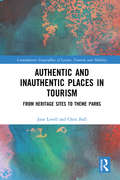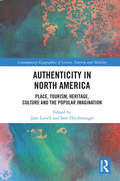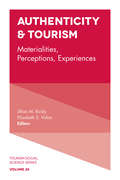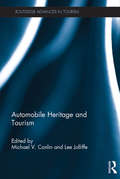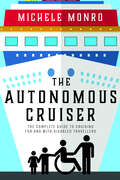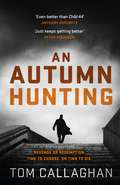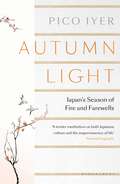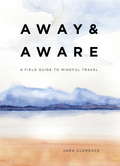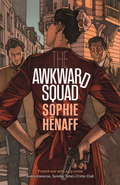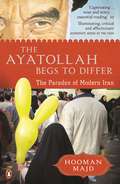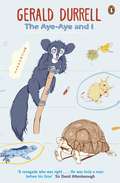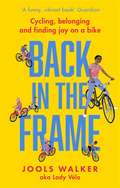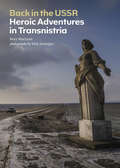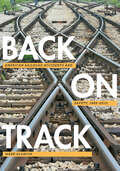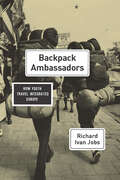- Table View
- List View
Authentic and Inauthentic Places in Tourism: From Heritage Sites to Theme Parks (Contemporary Geographies of Leisure, Tourism and Mobility)
by Chris Bull Jane LovellWith the rise of post-truth and fake news, a thorough examination of authenticity has never been so relevant. This book explores the geography of authenticity, investigating a wide variety of places used by tourists. Not only does it assess what might be described as the more traditional objects for examination – places such as the city, the countryside and the coast – it also includes chapters on art and place, hipster places, gentrification, heritage sites, film locations, photographed places and eventful places. Using a wide-angled lens on places reveals linkages and possibilities, enabling the book to skate across the surface of the geography of authenticity, locating the magically real heritage site, the poignant replica, the authenticated theme park, the unmasked carnival. In focusing on authentic and inauthentic places, this text provides a useful contribution to the understanding of how places are changing, how they are perceived, and how authenticity is embodied and performed within them. Authentic and Inauthentic Places in Tourism is an insightful study and an essential read for those involved in the study of geography, tourism, urban studies, culture and heritage.
Authenticity in North America: Place, Tourism, Heritage, Culture and the Popular Imagination (Contemporary Geographies of Leisure, Tourism and Mobility)
by Jane Lovell Sam HitchmoughThis interdisciplinary book addresses the highly relevant debates about authenticity in North America, providing a contemporary re-examination of American culture, tourism and commodification of place. Blending social sciences and humanities research skills, it formulates an examination of the geography of authenticity in North America, and brings together studies of both rurality and urbanity across the country, exposing the many commonalities of these different landscapes. Relph stated that nostalgic places are inauthentic, yet within this work several chapters explore how festivals and visitor attractions, which cultivate place heritage appeal, are authenticated by tourists and communities, creating a shared sense of belonging. In a world of hyperreal simulacra, post-truth and fake news, this book bucks the trend by demonstrating that authenticity can be found everywhere: in a mouthful of food, in a few bars of a Beach Boys song, in a statue of a troll, in a diffuse magical atmosphere, in the weirdness of the ungentrified streets. Written by a range of leading experts, this book offers a contemporary view of American authenticity, tourism, identity and culture. It will be of great interest to upper-level students, researchers and academics in Tourism, Geography, History, Cultural Studies, American Studies and Film Studies.
Authenticity in North America: Place, Tourism, Heritage, Culture and the Popular Imagination (Contemporary Geographies of Leisure, Tourism and Mobility)
by Jane Lovell Sam HitchmoughThis interdisciplinary book addresses the highly relevant debates about authenticity in North America, providing a contemporary re-examination of American culture, tourism and commodification of place. Blending social sciences and humanities research skills, it formulates an examination of the geography of authenticity in North America, and brings together studies of both rurality and urbanity across the country, exposing the many commonalities of these different landscapes. Relph stated that nostalgic places are inauthentic, yet within this work several chapters explore how festivals and visitor attractions, which cultivate place heritage appeal, are authenticated by tourists and communities, creating a shared sense of belonging. In a world of hyperreal simulacra, post-truth and fake news, this book bucks the trend by demonstrating that authenticity can be found everywhere: in a mouthful of food, in a few bars of a Beach Boys song, in a statue of a troll, in a diffuse magical atmosphere, in the weirdness of the ungentrified streets. Written by a range of leading experts, this book offers a contemporary view of American authenticity, tourism, identity and culture. It will be of great interest to upper-level students, researchers and academics in Tourism, Geography, History, Cultural Studies, American Studies and Film Studies.
Authenticity & Tourism: Materialities, Perceptions, Experiences (Tourism Social Science Series #24)
by Jillian M. Rickly Elizabeth S. VidonDebates around the concept of authenticity date to the earliest theories of tourism, as scholars attempted to understand motivations for traveling away from 'home' and touristic experiences of places far 'away'. Over time, theories of authenticity have burgeoned from epistemological to ontological notions drawing a broad range of philosophers into tourism research. This edited volume features chapters that engage with key debates about authenticity – its materiality, how it is perceived, and how it is experienced. The book is comprised of four sections thematically organized around popular trends in authenticity research in tourism, making this volume appropriate as both a comprehensive text and as individual investigations. Authenticity & Tourism: Materialities, Perceptions, Experiences includes chapters that engage with the pragmatic and the theoretical, including conversations on marketing and the production of tourism attractions, examinations of the constructive nature of authenticity, and the politics of authentication processes. Also included are contributions that revisit technological trends in tourism and advance debates of authenticity in souvenirs, photographs, and simulated experiences, as well as those more firmly anchored in the theoretical, pushing boundaries and establishing paths for future research. Across these chapters, the authors employ a range of methodologies, from autoethnography to photo and food-elicitation combinations to discourse and content analyses. Set against a backdrop of truly global case studies, this collection exemplifies the multiple facets of authenticity research in tourism.
Authenticity & Tourism: Materialities, Perceptions, Experiences (Tourism Social Science Series #24)
by Jillian M. Rickly Elizabeth S. VidonDebates around the concept of authenticity date to the earliest theories of tourism, as scholars attempted to understand motivations for traveling away from 'home' and touristic experiences of places far 'away'. Over time, theories of authenticity have burgeoned from epistemological to ontological notions drawing a broad range of philosophers into tourism research. This edited volume features chapters that engage with key debates about authenticity – its materiality, how it is perceived, and how it is experienced. The book is comprised of four sections thematically organized around popular trends in authenticity research in tourism, making this volume appropriate as both a comprehensive text and as individual investigations. Authenticity & Tourism: Materialities, Perceptions, Experiences includes chapters that engage with the pragmatic and the theoretical, including conversations on marketing and the production of tourism attractions, examinations of the constructive nature of authenticity, and the politics of authentication processes. Also included are contributions that revisit technological trends in tourism and advance debates of authenticity in souvenirs, photographs, and simulated experiences, as well as those more firmly anchored in the theoretical, pushing boundaries and establishing paths for future research. Across these chapters, the authors employ a range of methodologies, from autoethnography to photo and food-elicitation combinations to discourse and content analyses. Set against a backdrop of truly global case studies, this collection exemplifies the multiple facets of authenticity research in tourism.
Automobile Heritage and Tourism (Routledge Advances in Tourism)
by Michael V. Conlin Lee JolliffeAutomobile heritage encompasses a complex range of artefacts and activities. Beyond just historic vehicles which are the primary artefacts of this niche, it also includes communities of collectors and enthusiasts, private owners and public institutions, as well as historic motoring environments, literally thousands of museums, exhibitions and car shows throughout the world, and a range of paraphernalia that includes both original and replicated promotional materials, equipment and parts, and guide books. Although automobile heritage has been the subject of some limited research, Automobile Heritage and Tourism is unique in examining its scope and role within tourism. The book looks at a vast array of topics, from the experience of using and collecting old cars, related destination development, automobile heritage and museums, to events such as vintage automobile racing, promotion and social change. It thereby provides a thorough review of the impacts of automobile heritage on tourism. A number of theories provide a framework and are analysed throughout, including those related to the collection, display, exhibition and use of historic automobiles. The title takes a global and interdisciplinary view of the subject with international contributions from both established and emerging scholars in the field.This book adds to the industrial heritage tourism literature and will appeal to a diverse audience, in particular those in the fields of cultural heritage and industrial heritage tourism, but also practitioners involved with the planning, restoration, exhibition and management of automobile heritage attractions and events.
Automobile Heritage and Tourism (Routledge Advances in Tourism)
by Michael V. Conlin Lee JolliffeAutomobile heritage encompasses a complex range of artefacts and activities. Beyond just historic vehicles which are the primary artefacts of this niche, it also includes communities of collectors and enthusiasts, private owners and public institutions, as well as historic motoring environments, literally thousands of museums, exhibitions and car shows throughout the world, and a range of paraphernalia that includes both original and replicated promotional materials, equipment and parts, and guide books. Although automobile heritage has been the subject of some limited research, Automobile Heritage and Tourism is unique in examining its scope and role within tourism. The book looks at a vast array of topics, from the experience of using and collecting old cars, related destination development, automobile heritage and museums, to events such as vintage automobile racing, promotion and social change. It thereby provides a thorough review of the impacts of automobile heritage on tourism. A number of theories provide a framework and are analysed throughout, including those related to the collection, display, exhibition and use of historic automobiles. The title takes a global and interdisciplinary view of the subject with international contributions from both established and emerging scholars in the field.This book adds to the industrial heritage tourism literature and will appeal to a diverse audience, in particular those in the fields of cultural heritage and industrial heritage tourism, but also practitioners involved with the planning, restoration, exhibition and management of automobile heritage attractions and events.
The Autonomous Cruiser
by Michele MonroWith the expansion of the cruising sector, it is difficult to keep up as the goalposts keep changing, but one thing hasn't changed: the travel industry's inability to provide a disabled traveller with what they need to plan a stress-free adventure.Information on accessibility can be hard to find and the internet is filled with dead and out-of-date sites. Being disabled can be hard enough but I believe information is power, the power to be able to control our choices and know what we are going to come up against when we pick a cruise.This general how-to on cruising is the first of its kind, aimed at giving you the power to make your own choices, take control and organise the perfect seafaring holiday, getting the best out of both the ship and its destinations.Bon Voyage
An Autumn Hunting
by Tom Callaghan'Even better than Child 44. Akyl Borubaev is a terrific creation' Anthony Horowitz'Just keeps getting better . . . buy the whole series right away' Peter Robinson, No.1 bestselling author of Sleeping in the GroundNo sooner has Akyl Borubaev been reinstated as an Inspector in the Bishkek Murder Squad than he's suspended for alleged serious crimes against the state. After an attempted assassination of a prominent minister goes spectacularly wrong, Akyl is a fugitive from his former colleagues and involved with one of Kyrgyzstan's most dangerous criminals. On the run, caught up in a illegal scheme that can only end badly, it's time for Akyl to take a stand for everything he believes in.
Autumn Light: Japan's Season of Fire and Farewells
by Pico IyerFor decades now, Pico Iyer has been based for much of the year in Nara, Japan, where he and his Japanese wife, Hiroko, share a two-room apartment. But when his father-in-law dies suddenly, calling him back to Japan earlier than expected, Iyer begins to grapple with the question we all have to live with: how to hold on to the things we love, even though we know that we and they are dying.In a country whose calendar is marked with occasions honouring the dead, this question has a special urgency and currency. Iyer leads us through the autumn following his father-in-law's death, introducing us to the people who populate his days: his ailing mother-in-law, who often forgets that her husband has died; his absent brother-in-law, who severed ties with his family years ago but to whom Hiroko still writes letters; and the men and women in his ping-pong club, who, many years his senior, traverse their autumn years in different ways. And as the maple leaves begin to redden and the heat begins to soften, Iyer offers us a singular view of Japan, in the season that reminds us to take nothing for granted.
Avro Lancaster Bomber (large print)
by RnibThis page shows two images of an aircraft. At the top of the page seen from the side and in the bottom and middle of the page a plan view seen from above. There is a locator dot shown, which will be at the top left of the page when the image is the correct way up. Both views have the front on the left and the tail on the right of the page. The aircraft is shown in a flying position so the front wheels are retracted and not shown. The aircraft in the top of the page has a transparent nose cone on the left which is where the bomb aimer sits. Up and right from this is the fore gunner's turret. Up and right from this again is the main cockpit cover. Down from the cockpit are two propellers. They are attached to engines which hang off the wing. To the right of the propellers is a small rectangle which comprises six exhaust outlets on the outer side of the outside engine. Right from the exhaust is the tip of the wing pointing towards you. The centre of the fuselage has letters identifying which individual aircraft it is. There is also a red and blue roundel indicating the plane belongs to the RAF. On the top edge of the fuselage there is a gun turret with the gun pointing up and to the right. Right of this the fuselage continues to one of the vertical tail fins. On the right of this is a vertical flap. This is one of the ailerons used to manoeuvre the aircraft when it is flying. The tail has a red rectangle and a blue rectangle separated by a white line indicating the plane belongs to the RAF. Down from the tail fin is the single rear wheel. To the right of the tail is the rear gun turret with the gun pointing right and down. In the plan view image in the bottom and middle of the page the fuselage goes from left to right in the centre of the image. The main wings go up and down the page from the fuselage. On the left the fuselage starts with a transparent nose cone which is where the bomb aimer sits. Right from this is the fore gunner's turret. Its guns cross above the bomb aimer. Right from this is the main cockpit cover. There are two small hatches in the centre of the fuselage and right from them is a gun turret with the guns pointing to the right. The fuselage finishes on the right with the rear gun turret with the guns pointing to the right. In the centre of the page the main wings each have two engines and propellers sticking out to the left. To the right of the propellers six exhaust outlets can be found on the top and bottom edge of each engine. Towards the end of each wing is a red and blue roundel indicating the plane belongs to the RAF. On the right of each wing tip is a flap. These are two of the ailerons used to manoeuvre the aircraft when it is flying. On the right of the page is the tailplane. The right half of each tail wing is a flap. These are two more of the ailerons used to manoeuvre the aircraft when it is flying. The ends of the tail wing, up and down the page have the ends of the two vertical fins showing. The plane is green although it was also commonly painted with camouflage colours. The underside is dark grey or black. This would mean the aircraft was difficult to detect from the ground when out on night bombing raids.
Avro Lancaster Bomber (UEB contracted)
by RnibThis page shows two images of an aircraft. At the top of the page seen from the side and in the bottom and middle of the page a plan view seen from above. There is a locator dot shown, which will be at the top left of the page when the image is the correct way up. Both views have the front on the left and the tail on the right of the page. The aircraft is shown in a flying position so the front wheels are retracted and not shown. The aircraft in the top of the page has a transparent nose cone on the left which is where the bomb aimer sits. Up and right from this is the fore gunner's turret. Up and right from this again is the main cockpit cover. Down from the cockpit are two propellers. They are attached to engines which hang off the wing. To the right of the propellers is a small rectangle which comprises six exhaust outlets on the outer side of the outside engine. Right from the exhaust is the tip of the wing pointing towards you. The centre of the fuselage has letters identifying which individual aircraft it is. There is also a red and blue roundel indicating the plane belongs to the RAF. On the top edge of the fuselage there is a gun turret with the gun pointing up and to the right. Right of this the fuselage continues to one of the vertical tail fins. On the right of this is a vertical flap. This is one of the ailerons used to manoeuvre the aircraft when it is flying. The tail has a red rectangle and a blue rectangle separated by a white line indicating the plane belongs to the RAF. Down from the tail fin is the single rear wheel. To the right of the tail is the rear gun turret with the gun pointing right and down. In the plan view image in the bottom and middle of the page the fuselage goes from left to right in the centre of the image. The main wings go up and down the page from the fuselage. On the left the fuselage starts with a transparent nose cone which is where the bomb aimer sits. Right from this is the fore gunner's turret. Its guns cross above the bomb aimer. Right from this is the main cockpit cover. There are two small hatches in the centre of the fuselage and right from them is a gun turret with the guns pointing to the right. The fuselage finishes on the right with the rear gun turret with the guns pointing to the right. In the centre of the page the main wings each have two engines and propellers sticking out to the left. To the right of the propellers six exhaust outlets can be found on the top and bottom edge of each engine. Towards the end of each wing is a red and blue roundel indicating the plane belongs to the RAF. On the right of each wing tip is a flap. These are two of the ailerons used to manoeuvre the aircraft when it is flying. On the right of the page is the tailplane. The right half of each tail wing is a flap. These are two more of the ailerons used to manoeuvre the aircraft when it is flying. The ends of the tail wing, up and down the page have the ends of the two vertical fins showing. The plane is green although it was also commonly painted with camouflage colours. The underside is dark grey or black. This would mean the aircraft was difficult to detect from the ground when out on night bombing raids.
Avro Lancaster Bomber (UEB uncontracted)
by RnibThis page shows two images of an aircraft. At the top of the page seen from the side and in the bottom and middle of the page a plan view seen from above. There is a locator dot shown, which will be at the top left of the page when the image is the correct way up. Both views have the front on the left and the tail on the right of the page. The aircraft is shown in a flying position so the front wheels are retracted and not shown. The aircraft in the top of the page has a transparent nose cone on the left which is where the bomb aimer sits. Up and right from this is the fore gunner's turret. Up and right from this again is the main cockpit cover. Down from the cockpit are two propellers. They are attached to engines which hang off the wing. To the right of the propellers is a small rectangle which comprises six exhaust outlets on the outer side of the outside engine. Right from the exhaust is the tip of the wing pointing towards you. The centre of the fuselage has letters identifying which individual aircraft it is. There is also a red and blue roundel indicating the plane belongs to the RAF. On the top edge of the fuselage there is a gun turret with the gun pointing up and to the right. Right of this the fuselage continues to one of the vertical tail fins. On the right of this is a vertical flap. This is one of the ailerons used to manoeuvre the aircraft when it is flying. The tail has a red rectangle and a blue rectangle separated by a white line indicating the plane belongs to the RAF. Down from the tail fin is the single rear wheel. To the right of the tail is the rear gun turret with the gun pointing right and down. In the plan view image in the bottom and middle of the page the fuselage goes from left to right in the centre of the image. The main wings go up and down the page from the fuselage. On the left the fuselage starts with a transparent nose cone which is where the bomb aimer sits. Right from this is the fore gunner's turret. Its guns cross above the bomb aimer. Right from this is the main cockpit cover. There are two small hatches in the centre of the fuselage and right from them is a gun turret with the guns pointing to the right. The fuselage finishes on the right with the rear gun turret with the guns pointing to the right. In the centre of the page the main wings each have two engines and propellers sticking out to the left. To the right of the propellers six exhaust outlets can be found on the top and bottom edge of each engine. Towards the end of each wing is a red and blue roundel indicating the plane belongs to the RAF. On the right of each wing tip is a flap. These are two of the ailerons used to manoeuvre the aircraft when it is flying. On the right of the page is the tailplane. The right half of each tail wing is a flap. These are two more of the ailerons used to manoeuvre the aircraft when it is flying. The ends of the tail wing, up and down the page have the ends of the two vertical fins showing. The plane is green although it was also commonly painted with camouflage colours. The underside is dark grey or black. This would mean the aircraft was difficult to detect from the ground when out on night bombing raids.
Avro York RAF Aircraft (large print)
by RnibThis is an image of an aircraft seen from above. There is a locator dot shown, which will be at the top left of the page when the image is the correct way up. The image is in the centre and a scale in metres on the left of the page. The aircraft's nose is in the top centre and the tail in the bottom centre of the page. The fuselage goes up and down the middle of the page. The cockpit is shown as a three sided window near the nose. The wings go out to the left and right. Sticking out from the front edge of the wing there are two engines with propellers to the left and right of the fuselage. The bottom edge of the wing has two flaps on each side and the tail wing has one flap on each side. These are the ailerons used to manoeuvre the aircraft when it is flying. The tailplane has three vertical tails, one in the middle and one to either side. The aircraft is pale grey. The textures on the tactile image reflect structure not colour. There is a different texture for the cockpit, wings, fuselage and engines.
Away & Aware: A Field Guide to Mindful Travel
by Sara Clemence'Ideal for anyone looking to add a little more joy to their journeys' -- Woman's Way'A timely exhortation to slow down and become more mindful of what has been lost by trading in analog pleasures for digital ones' -- Perceptive TravelUnlike almost every travel book, this one is not about where to go, but how to go.As our daily lives are dominated by devices and an always-connected mentality, more people are using their precious vacation time as an excuse to unplug and re-engage with their surroundings?and themselves.Away & Aware is a beautifully illustrated guide to more mindful travel, with tips and advice for planning off-the-grid trips, minimalist packing, unplugging on the road, connecting with local culture, travelling with children, and easing back into the real world after returning from a trip.
Awesome Achievers in Science: Super and Strange Facts about 12 Almost Famous History Makers (Awesome Achievers #2)
by Alan KatzPart of a super fun middle grade series, Awesome Achievers in Science puts the spotlight on lesser-known heroes and their contributions in major scientific fields.Everyone has heard the names Neil Armstrong and Buzz Aldrin, but what about Michael Collins--the third brave Apollo 11 astronaut who didn't get to walk on the moon? Many of the most relevant figures in scientific history have remained in the shadows, but not any longer! From Alan Katz's new Awesome Achievers series, Awesome Achievers in Science gives kids a look behind the scenes at 12 lesser-known scientists whose contributions are personally relevant to their lives today. Each figure is given a traditional biography but is also subject to Katz's unique brand of silliness, with humorous elements such as imagined poems, song lyrics, and diary entries by or about the not-so-famous figure accompanying each bio. Spot illustrations throughout add to the lighthearted and appreciative humor each figure receives. Reluctant readers and budding scientists alike will delight in this imaginative and engaging continuation of a new series of laugh-out-loud biographies.
The Awkward Squad (MacLehose Press Editions)
by Sophie HénaffSuspended from her job as a promising police officer for firing "one bullet too many", Anne Capestan is expecting the worst when she is summoned to H.Q. to learn her fate. Instead, she is surprised to be told that she is to head up a new police squad, working on solving old cold cases.Though relieved to still have a job, Capestan is not overjoyed by the prospect of her new role. Even less so when she meets her new team: a crowd of misfits, troublemakers and problem cases, none of whom are fit for purpose and yet none of whom can be fired.But from this inauspicious start, investigating the cold cases throws up a number a number of strange mysteries for Capestan and her team: was the old lady murdered seven years ago really just the victim of a botched robbery? Who was behind the dead sailor discovered in the Seine with three gunshot wounds? And why does there seem to be a curious link with a ferry that was shipwrecked off the Florida coast many years previously?Translated from the French by Sam Gordon
The Ayatollah Begs to Differ: The Paradox of Modern Iran
by Hooman MajdHooman Majd, acclaimed journalist and New York-residing grandson of an Ayatollah, has a unique perspective on his Iranian homeland. In this vivid, warm and humorous insider's account, he opens our eyes to an Iran that few people see, meeting opium-smoking clerics, women cab drivers and sartorially challenged presidential officials, among others. Revealing a country where both t-shirt wearing teenagers and religious martyrs express pride in their Persian origins, that is deeply religious yet highly cosmopolitan, authoritarian yet reformist, this is the one book you should read to understand Iran and Iranians today.
The Aye-Aye and I: A Rescue Journey To Save One Of The World's Most Intriguing Creatures From Extinction
by Gerald Durrell'In the gloom it came along the branches towards me, its round, hypnotic eyes blazing, its spoon-like ears turning to and fro independently like radar dishes . . . it was Lewis Carroll's Jabberwocky come to life . . . one of the most incredible creatures I had ever been privileged to meet.'The fourth largest island in the world, Madagascar is home to woodlice the size of golf balls, moths the size of Regency fans and the Aye-Aye, a type of lemur held by local superstion to be an omen of death. But when Gerald Durrell visited the island, the destruction of the forests meant that the Aye-Aye and many other creatures were in danger of extinction.Told with his unique sense of humour and inimitable charm, Gerald Durrell's The Aye Aye and I is the final adventure from one Britain's best loved conservationists.
Back in the Frame: How to get back on your bike, whatever life throws at you
by Jools WalkerA memoir of bikes, blogs and riding through depression from award-winning blogger, Lady Vélo.Jools Walker re-discovered cycling aged twenty-eight after a ten-year absence from the saddle. When she started blogging about her cycle adventures under the alias Lady Vélo, a whole world was opened up to her. But it's hard to find space in an industry not traditionally open to women - especially women of colour.Shortly after getting back on two wheels, Jools was diagnosed with depression and then, in her early thirties, hit by a mini-stroke. Yet, through all of these punctures, one constant remained: Jools' love of cycling.In Back in the Frame Jools talks to the other female trailblazers who are disrupting the cycling narrative as well as telling the story of how she overcame her health problems, learned how to cycle her own path and even found a love of Lycra shorts along the way.
Back in the USSR: Heroic Adventures in Transnistria
by Rory Maclean Nick DanzigerIan Fleming could not have imagined a better place to set a thriller: an upstart mini-state on the edge of Europe, Transnistria is a nowhereland, a Soviet museum occupied by Russian peace-keepers near the Black Sea. <P><P>Its oligarchs in Adidas tracksuits hunt wild boar with AK-47s. Its young people train for revolution at the Che Guevara High School of Political Leadership. Its secret factories have supplied arms to Chechnya and electrical cable to Iran's Bushehr nuclear power plant. Its isolation and tiny size belie the real threat it poses to the West. To many observers, Transnistria is the North Korea of Europe. <P><P>Yet its new president has launched a cunning coup of political marketing, appointing as his top ministers personable young women like the Facebook-savvy Cheryl Cole lookalike Foreign Minister, sexing-up the republic's image abroad, and using their glitter to obscure this internationally unrecognised non-state's shadowy past. Now Western ambassadors and foreign ministers are queuing up to meet them. <P><P>Rory MacLean and Nick Danziger, two of Europe's most intrepid travellers and chroniclers, document life in the only country in the world not to have recognised the collapse of the Soviet Union. Readers will find themselves truly back in the USSR… with a difference.
Back on Track: American Railroad Accidents and Safety, 1965;€“2015 (Hagley Library Studies in Business, Technology, and Politics)
by Mark AldrichThroughout the early twentieth century, railroad safety steadily improved across the United States. But by the 1960s, American railroads had fallen apart, the result of a regulatory straightjacket that eroded profitability and undermined safety. Collisions, derailments, worker fatalities, and grade crossing mishaps skyrocketed, while hazmat disasters exploded into newspaper headlines. In Back on Track, his sequel to Death Rode the Rails, Mark Aldrich traces the history of railroad accidents beginning in 1965, when Congress responded to bankrupt and scandal-ridden carriers by enacting a new safety regime. Aldrich details the federalization of rail safety and the implementation of a massive grade crossing program. He touches on post-1976 economic deregulation, which provided critical financing that underwrote better public safety. He also explores how the National Transportation Safety Board acted as a public scold to shine bright lights on private failings, while Federal Railroad Administration regulations reinforced market incentives for better safety. Ultimately, Aldrich concludes, the past 50 years have seen great strides in restoring railroad safety while enhancing industry profitability. Arguing that it was not inadequate safety regulation but rather stifling economic regulation that initially caused an uptick in train accidents, Back on Track is both a paen to the return of more competitive railroading and the only comprehensive history of the safety of modern American railroads. Praise for Death Rode the Rails"A masterful study of the complex evolution of railroad safety.";¢;‚¬;€?American Historical Review"Students of rail safety, and today's Class I railroad managers, need to read this volume.";¢;‚¬;€?Trains"Aldrich has created a masterpiece. His research is extensive, drawing on a rich variety of obscure yet relevant sources.";¢;‚¬;€?Register of the Kentucky Historical Society"One of the first large-scale scholarly studies of railroad safety in America.";¢;‚¬;€?Railroad History"A thought-provoking and well-grounded contribution to the history of American economic development.";¢;‚¬;€?Journal of American History"Pioneering... A central message of Aldrich's book is that 'little accidents' played a crucial though until now largely hidden role in the gradual evolution of a risk society.";¢;‚¬;€?Technology and Culture"A work of merit... essential reading for historians of transport safety, business, and technology.";¢;‚¬;€?Journal of Transport History"Impressive and thoroughly researched... Demonstrates how railroad safety evolved from the intersection of market pressures, technology, and public sentiment.";¢;‚¬;€?Journal of Southern History
Backpack Ambassadors: How Youth Travel Integrated Europe
by Richard Ivan JobsEven today, in an era of cheap travel and constant connection, the image of young people backpacking across Europe remains seductively romantic. In Backpack Ambassadors, Richard Ivan Jobs tells the story of backpacking in Europe in its heyday, the decades after World War II, revealing that these footloose young people were doing more than just exploring for themselves. Rather, with each step, each border crossing, each friendship, they were quietly helping knit the continent together. From the Berlin Wall to the beaches of Spain, the Spanish Steps in Rome to the Pudding Shop in Istanbul, Jobs tells the stories of backpackers whose personal desire for freedom of movement brought the people and places of Europe into ever-closer contact. As greater and greater numbers of young people trekked around the continent, and a truly international youth culture began to emerge, the result was a Europe that, even in the midst of Cold War tensions, found its people more and more connected, their lives more and more integrated. Drawing on archival work in eight countries and five languages, and featuring trenchant commentary on the relevance of this period for contemporary concerns about borders and migration, Backpack Ambassadors brilliantly recreates a movement that was far more influential and important than its footsore travelers could ever have realized.
Backpack Ambassadors: How Youth Travel Integrated Europe
by Richard Ivan JobsEven today, in an era of cheap travel and constant connection, the image of young people backpacking across Europe remains seductively romantic. In Backpack Ambassadors, Richard Ivan Jobs tells the story of backpacking in Europe in its heyday, the decades after World War II, revealing that these footloose young people were doing more than just exploring for themselves. Rather, with each step, each border crossing, each friendship, they were quietly helping knit the continent together. From the Berlin Wall to the beaches of Spain, the Spanish Steps in Rome to the Pudding Shop in Istanbul, Jobs tells the stories of backpackers whose personal desire for freedom of movement brought the people and places of Europe into ever-closer contact. As greater and greater numbers of young people trekked around the continent, and a truly international youth culture began to emerge, the result was a Europe that, even in the midst of Cold War tensions, found its people more and more connected, their lives more and more integrated. Drawing on archival work in eight countries and five languages, and featuring trenchant commentary on the relevance of this period for contemporary concerns about borders and migration, Backpack Ambassadors brilliantly recreates a movement that was far more influential and important than its footsore travelers could ever have realized.
Backpack Ambassadors: How Youth Travel Integrated Europe
by Richard Ivan JobsEven today, in an era of cheap travel and constant connection, the image of young people backpacking across Europe remains seductively romantic. In Backpack Ambassadors, Richard Ivan Jobs tells the story of backpacking in Europe in its heyday, the decades after World War II, revealing that these footloose young people were doing more than just exploring for themselves. Rather, with each step, each border crossing, each friendship, they were quietly helping knit the continent together. From the Berlin Wall to the beaches of Spain, the Spanish Steps in Rome to the Pudding Shop in Istanbul, Jobs tells the stories of backpackers whose personal desire for freedom of movement brought the people and places of Europe into ever-closer contact. As greater and greater numbers of young people trekked around the continent, and a truly international youth culture began to emerge, the result was a Europe that, even in the midst of Cold War tensions, found its people more and more connected, their lives more and more integrated. Drawing on archival work in eight countries and five languages, and featuring trenchant commentary on the relevance of this period for contemporary concerns about borders and migration, Backpack Ambassadors brilliantly recreates a movement that was far more influential and important than its footsore travelers could ever have realized.
